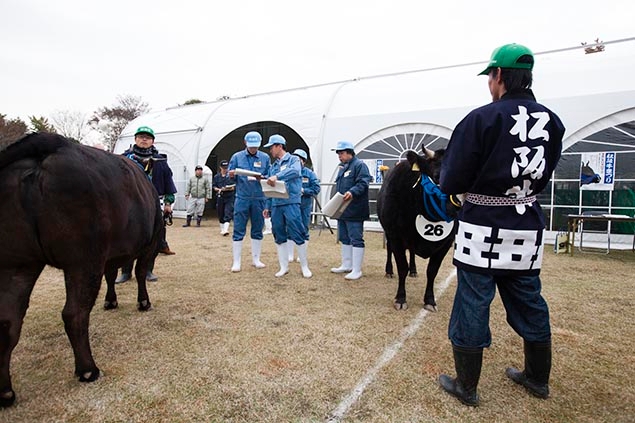The secrets to superlative flavor

Sleek fat premium Matsusaka beef cattle line up patiently in a huge tent serving as the standby area. Proceedings begin with the farmers and traders taking part in the auction, scrutinizing the cattle themselves to find the best prospects.
Japanese beef consumption dates back only as far as the Meiji era. After Emperor Meiji dined on beef in 1872, the meat quickly gained popularity, and as a producer of goodquality cattle the Matsusaka region began sending its livestock to other parts of the country in response to demand.
Today, “Matsusaka beef” is managed as a brand by several related bodies, starting with the producers' organization – the Matsusaka Ushi Kyogikai (Matsusaka Cattle Council) – and the majority of the meat is sold at stores belonging to the Matsusaka Nikugyu Kyokai (Matsusaka Beef Cattle Association). These stores display an “Association member's certificate” or “approved Matsusaka meat retailer certificate”, with the “Matsusaka beef” sticker placed in front of meat in the chiller cabinets. The sticker serves as proof of the meat's provenance. This level of control, right down to the level of individual cuts, is to guard against cheap meat being sold to consumers under false pretenses as “Matsusaka beef”.
To prevent this kind of dishonest practice, in August 2002, a step ahead of the national authorities, the Mie Prefecture Matsusaka Shokuniku Kosha public corporation introduced an ID system for individual Matsusaka cattle. Matsusaka cattle on feedlot farms are assigned a 10-digit number and tracked all the way from farmer to slaughter, and then to distribution. Consumers can visit a website and enter the number shown on the Matsusaka beef sticker into the “Matsusaka beef unit identity control system” to find out everything from the animal's name to its date of birth, place of birth, where it was fattened, its bloodline back three generations, plus the feedlot name and number of days the animal underwent fattening. The date the cow was slaughtered, date of shipping, address and telephone number of the purchaser of the carcass are also included, providing reassurance regarding the safety of the meat purchased (only available in Japanese).
Why is the Matsusaka beef brand protected in this way? Because quite simply, it tastes so good.
This is due to:
1. Its delicate marbled fat (shimofuri) and tenderness
2. Its sweet, full-bodied, refined fragrance
3. The low melting point of its fat, making for excellent mouthfeel
This delectableness is the subject of research by the Mie Prefecture Livestock Research Institute. According to senior researcher Takeo Miyake, the wonderful melt-in-the-mouth quality that sets Matsusaka beef apart is due to unsaturated fatty acids.
